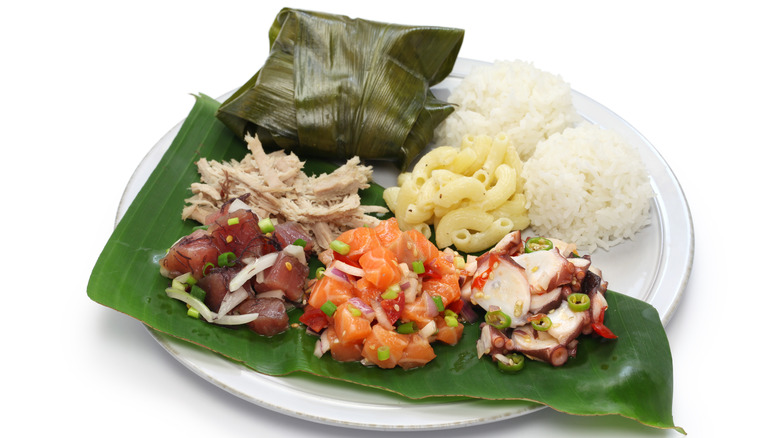Lomi Lomi: The Salted Salmon That's A Must-Have For Hawaiian Holidays
When it comes to Hawaiian cuisine, you may have heard of trendy dishes like poke bowls or Spam musubi. However, the islands' food scene is much richer and wider than this, with diverse influences and complex flavors. In fact, according to The Hawaiian Islands, their cuisine is a guide through the islands' colonial history — beginning with the diet of the first Hawaiian natives to the arrival of new immigrants. The main cuisines can be broken into "local food" and "Hawaiian food."
Local cuisine refers to food that is not native to the islands originally. According to The Hawaii Islands, local cuisine was developed in the late 1800s when many laborers arrived on the islands to work on its many plantations. In doing so, they introduced ingredients and recipes from their motherlands, which included China, Japan, the Philippines, Portugal, and Puerto Rico. Local dishes include plate lunches (often made with rice, various meat, and macaroni salad), teriyaki beef, and butter mochi, according to Food & Wine. These dishes in particular were created on the islands but include ingredients that were introduced to Hawaii.
Native Hawaiian food, however, is more indigenous to the islands than local food. This includes foods like kalua pig, Pa'i'ai, kalo, and lomi lomi. Lomi lomi, which means "rub, rub" in Hawaiian, is a salted salmon side dish that has an important place in traditional luaus and in Hawaiian homes (via 'Ono Hawaiian Recipes).
Before Spam, there was Lomi Lomi
According to 'Ono Hawaiian Recipes, lomi lomi is traditionally made with cubed salmon that is "rubbed" with salt and chilled to cure for a day. The recipe is quite simple, as the raw salmon is mixed with tomatoes, yellow and green onions, and lemon juice, sugar, and pepper. According to Food & Wine, none of those main ingredients are native to the islands. But Hawaii doesn't mind breaking its own rule as lomi lomi is still considered a central part of the Hawaiian food canon.
The outlet credits time and tradition as the reason lomi lomi worked its way onto potluck tables and nearly every Hawaiian family gathering. Whether it is present as a side dish at a luau or on a church event's meal table, tubs of lomi lomi are an essential and inexpensive Hawaiian treat. There's no reason to wait to visit (or revisit) the islands to enjoy this simple and delicious snack.

